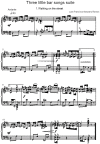Influence of Tempo and Rhythmic Unit in Musical Emotion Regulation
- PMID: 27536232
- PMCID: PMC4971092
- DOI: 10.3389/fncom.2016.00080
Influence of Tempo and Rhythmic Unit in Musical Emotion Regulation
Abstract
This article is based on the assumption of musical power to change the listener's mood. The paper studies the outcome of two experiments on the regulation of emotional states in a series of participants who listen to different auditions. The present research focuses on note value, an important musical cue related to rhythm. The influence of two concepts linked to note value is analyzed separately and discussed together. The two musical cues under investigation are tempo and rhythmic unit. The participants are asked to label music fragments by using opposite meaningful words belonging to four semantic scales, namely "Tension" (ranging from Relaxing to Stressing), "Expressiveness" (Expressionless to Expressive), "Amusement" (Boring to Amusing) and "Attractiveness" (Pleasant to Unpleasant). The participants also have to indicate how much they feel certain basic emotions while listening to each music excerpt. The rated emotions are "Happiness," "Surprise," and "Sadness." This study makes it possible to draw some interesting conclusions about the associations between note value and emotions.
Keywords: emotion regulation; music; note value; rhythmic unit; tempo.
Figures







Similar articles
-
Musical pleasure beneficially alters stride and arm swing amplitude during rhythmically-cued walking in people with Parkinson's disease.Hum Mov Sci. 2020 Dec;74:102718. doi: 10.1016/j.humov.2020.102718. Epub 2020 Nov 21. Hum Mov Sci. 2020. PMID: 33232856
-
Sad music induces pleasant emotion.Front Psychol. 2013 Jun 13;4:311. doi: 10.3389/fpsyg.2013.00311. eCollection 2013. Front Psychol. 2013. PMID: 23785342 Free PMC article.
-
Emotional expression through musical cues: A comparison of production and perception approaches.PLoS One. 2022 Dec 30;17(12):e0279605. doi: 10.1371/journal.pone.0279605. eCollection 2022. PLoS One. 2022. PMID: 36584186 Free PMC article.
-
Music evokes vicarious emotions in listeners.Front Psychol. 2014 May 30;5:431. doi: 10.3389/fpsyg.2014.00431. eCollection 2014. Front Psychol. 2014. PMID: 24910621 Free PMC article. Review.
-
[Neuroarchitecture of musical emotions].Rev Neurol. 2013 Mar 1;56(5):289-97. Rev Neurol. 2013. PMID: 23440757 Review. Spanish.
Cited by
-
The Effects of a Multidimensional Exercise Program on Health Behavior and Biopsychological Factors in Mexican Older Adults.Front Psychol. 2020 Jan 24;10:2668. doi: 10.3389/fpsyg.2019.02668. eCollection 2019. Front Psychol. 2020. PMID: 32038344 Free PMC article.
-
Arousal Detection in Elderly People from Electrodermal Activity Using Musical Stimuli.Sensors (Basel). 2020 Aug 25;20(17):4788. doi: 10.3390/s20174788. Sensors (Basel). 2020. PMID: 32854302 Free PMC article.
-
Does music counteract mental fatigue? A systematic review.PLoS One. 2025 Jan 3;20(1):e0316252. doi: 10.1371/journal.pone.0316252. eCollection 2025. PLoS One. 2025. PMID: 39752412 Free PMC article.
-
Music-Enhanced Analgesia and Antiseizure Activities in Animal Models of Pain and Epilepsy: Toward Preclinical Studies Supporting Development of Digital Therapeutics and Their Combinations With Pharmaceutical Drugs.Front Neurol. 2019 Mar 27;10:277. doi: 10.3389/fneur.2019.00277. eCollection 2019. Front Neurol. 2019. PMID: 30972009 Free PMC article.
-
Scoping Review on the Use of Music for Emotion Regulation.Behav Sci (Basel). 2024 Sep 9;14(9):793. doi: 10.3390/bs14090793. Behav Sci (Basel). 2024. PMID: 39336008 Free PMC article.
References
-
- Bergeson T., Trehub S. (2005). Infants perception of rhythmic patterns. Music Percept. 23, 345–360. 10.1525/mp.2006.23.4.345 - DOI
-
- Brattico E. (2006). Cortical Processing of Musical Pitch as Reflected by Behavioural and Electrophysiological Evidence. Ph.D. dissertation, Helsinki University.
-
- Castillo J., Carneiro D., Serrano-Cuerda J., Novais P., Fernández-Caballero A., Neves J. (2014a). A multi-modal approach for activity classification and fall detection. Int. J. Syst. Sci. 45, 810–824. 10.1080/00207721.2013.784372 - DOI
LinkOut - more resources
Full Text Sources
Other Literature Sources

